Heights have never been my thing, but I’ll do just about anything to see wildlife. That being said, I refused to budge from the lefthand corner of the birding platform. That particular corner, I had decided, looked the most structurally sound. If I didn't move, and just focused on the thick layer of treetops around me, my mind could almost be convinced that I was at ground level. I didn't dare look at my feet and down through the thin layer of metal mesh that separated me from a two-hundred foot drop to the jungle floor.
As I had climbed the three stories of the tower, I could feel the entire structure shudder under each step. We had run out of carabiners, so our guide Daniel, did his best to tie my harness straps into a large knot across my chest. There’s not really such a thing as “up to code” in the Amazon. The floor at the top level of the tower had an unsettling springiness to it, popping out from beneath my boots with a jaw-clenching TWANG. The guard railings only came up to my hips, not that they needed to be any higher, but I’d still have appreciated it.
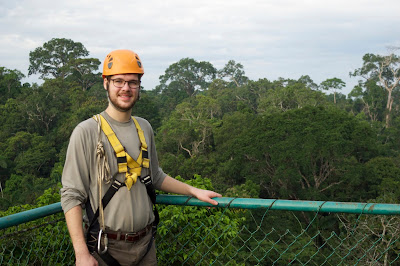 |
| Myself at the top of the bird tower. |
It was full darkness when we had arrived. Now, an hour later, the sun was just beginning to peak above the horizon. I could hear the deep whooping calls of howler monkeys from almost every direction. One group grew so loud that I kept expecting to see a brigade of the orange primates tumbling through the trees towards us. For better or worse, none ever appeared. A few parrots flew high over head, winged shadows too distant to identify or photograph. I waited patiently, anticipating a flock of colorful birds to engulf us at any moment.
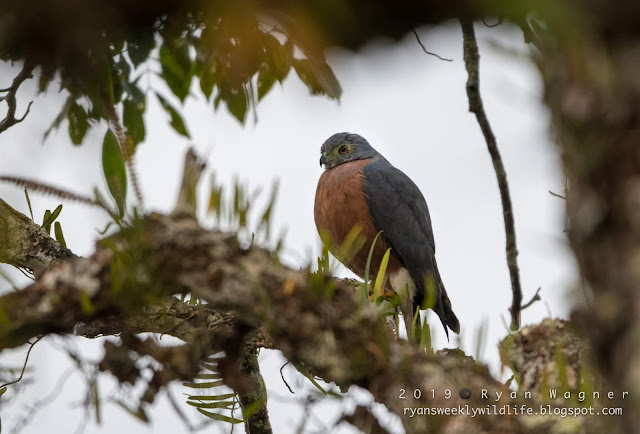 |
| Double-toothed Kite. |
As the sun rose, the air quickly began to heat up. Soon I was sweating, and I still hadn't seen so much as a single bird at close range. Finally, the birding gods seemed to take pity on me, and a raptor landed on the tree in front of me. It was a female Double-toothed Kite, a striking hawk with a bright, red belly, and a gray back and head. As it sat there, however, I began to realize that this predator was keeping all the other birds away. After another hour of this, it was time to head back to the station for breakfast. As I began my decent, the kite flew off, and I watched in agony as two unidentifiable bird species took its place, squawking back and forth at each other, taunting me.
 |
Many-banded Aracari.
|
Despite the bird tower being something of a bust, the understory birds were anything but shy. Highlights of the trip included toucans, several species of kites, a very friendly captive parrot, and countless hummingbirds (these were seen in the cloud forest—more on them later)
Each morning, I was woken by a cacophony of bird song. After our first night at the station, I hadn't been planning to wake up early, but the birds had something else in mind. Still in my pajamas, I walked out of the air conditioned dormitory and was abruptly slapped in the face by a wave of hot, humid air. I staggered forward feeling as if a brick had been dropped on my chest. My nostrils stung from the thick mustiness in the air and I could practically feel water condensing on my skin as I wiped the fog from my glasses. It didn't take long to realize that the nighttime katydids and frogs had been completely replaced by a totally new cast of daytime characters.
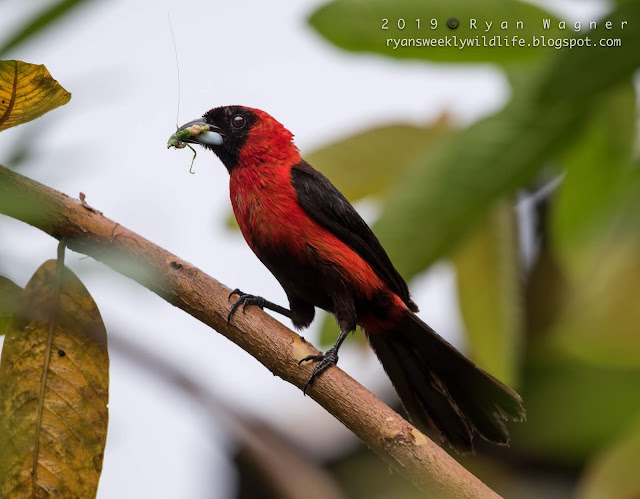 |
| Masked Crimson Tanager. |
As the sun was beginning to rise, I looked down from the balcony at the source of the mourning chorus. Birds of bright primary colors danced on the branches just feet from where I stood. A scarlet bird with a black face, wings, and tail landed in the tree in front of me and hopped down into what I realized was a nest full of babies. It dropped off a juicy caterpillar before fleeing to an adjacent tree and chasing off a black-colored bird with a blue-gray bill (which upon closer inspection actually had a dark maroon head that was only black at a distance).
 |
| Silver-beaked Tanager. |
These turned out to be the Masked Crimson Tanager and the Silver-beaked Tanager, both species of modified habitat and some of the most frequently seen birds at the station. They would often fly from tree to tree uttering a loud tchink call before examining the foliage for insects. North America is home to only three tanager species; Ecuador alone has upwards of 120. With a documented 1,600 different bird species across the country and nearby Galapagos Islands, Ecuador is an epicenter of avian diversity.
 |
| Tropical Kingbird. |
The more I looked, the more birds and the more colors, I saw. A brilliantly yellow Tropical Kingbird, scanned the lawn from an exposed perch. It darted into the air in a wide arc, hawking insects on the wing, before returning to the same branch. A similar looking species called a Great Kiskadee watched nearby. Its head was strikingly patterned with stripes of black and white.
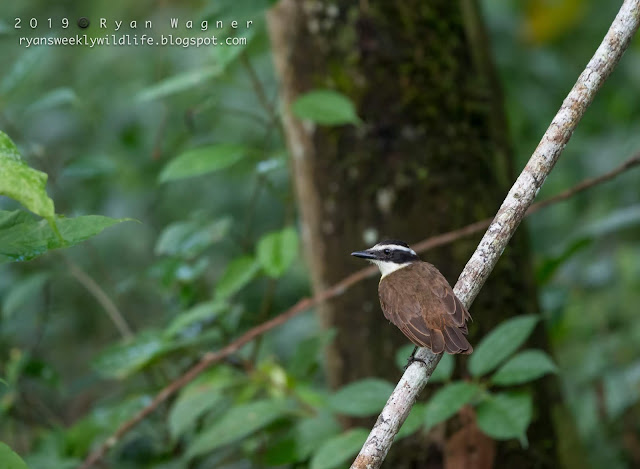 |
| Great Kiskadee. |
Unlike North American birds, most species in South America don’t bother to migrate. Food and resources are abundant all year round at the equator. The species that do travel are often Neotropical migrants from North America. The same bird I might catch a glimpse of at Magee Marsh in northern Ohio could travel thousands of miles to overwinter in Ecuador’s tropical rainforest. I knew to keep a lookout for familiar faces while observing Ecuador’s avifauna, but I never expected to see a Red-eyed Vireo feeding alongside the Amazonian tanagers. Red-eyed Vireos breed in Ohio and across much of the United States and Canada. Their hear-I-am, over-here call is a common and conspicuous sound in summertime Athens.
 |
| Red-eyed Vireo. |
I hadn't seen a Red-eyed Vireo since late last summer as they were beginning their southbound migration. It was a bit of a shock to see one here looking as exotic as any of the other Ecuador birds. I could have easily mistaken this little songbird for another indigenous South American species—but, luckily I knew better. Not unlike myself, this bird was here for only a little while and would soon make the trek back north.
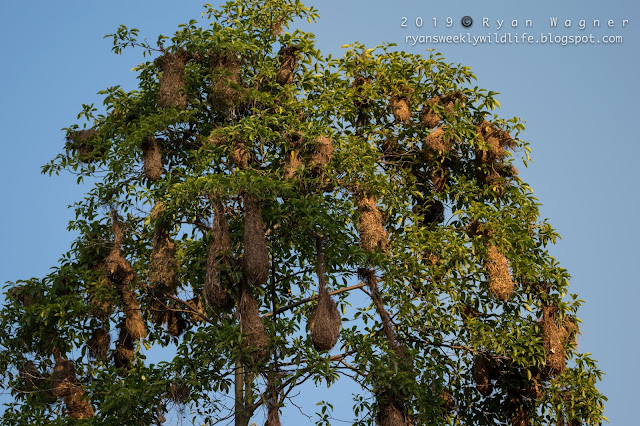 |
| Oropendola nests. |
As I continued to explore the research station, I quickly noticed a large tree that held at least thirty huge, teardrop-shaped structures. These turned out to be a colony of Russet-backed Oropendolas, large songbirds which build the structures from the surrounding vegetation. Oropendolas are boisterous birds, extremely active during the day as they gather nesting material. Their call is a loud, water-droplet like gurgle, which is made by leaning forward, wings outstretched, before rapidly arching back up into a sitting position.
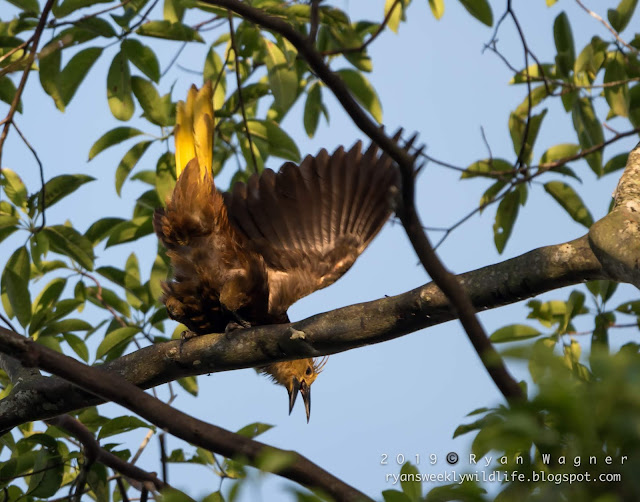 |
| Russet-backed Oropendola. |
Just hiking around the field station provided new species at almost every turn, but I was eager to see what lived beyond its boundaries. The third morning, we boarded a canoe and began a trip down the river. Almost immediately, a huge, black bird took off from the adjacent bank, something long and orange trailing from its talons. I focused in with my camera, and my jaw dropped. The bird was holding a snake!
 |
| Great-black Hawk with a snake. |
Lucky for us, the hawk perched just around the bend, and I was able to get a better look at the predator and its prey. I would have liked to have seen the snake alive (snakes can be pretty hard to come by in the tropics—this was the only one I saw) but it was incredible to witness this predator in action. At first, I thought the huge bird must be some sort of eagle, but after inspecting my field guide, I realized it was a Great-black Hawk. This is a widespread species, ranging across much of South America and into coastal Mexico. One recent individual even found its way into Maine this year, to the delight of local birders.
 |
| Great-black Hawk with a Snake. |
The canoe would eventually bring us to a salt pool, known among the local tribes as a prime wildlife hotspot. Tapirs, wild hogs, and countless species of birds flock here to drink the mineral rich water. As we approached the muddy shore, we scared a half dozen charapas, or Yellow-spotted River Turtles from a log. A large Cocoi Heron (South America’s version of the great blue heron) took flight as our guide tied our boat to some exposed tree roots.
 |
| Yellow-spotted River Turtles. |
One by one, we proceeded to scale a very steep, very slippery bank. Being the dry season, the river was unusually low, making our exit that much more ungraceful. Using the rope to steady myself, I felt my palms being rubbed raw as I struggled to keep my feet on the rapidly eroding ground beneath me. As we hiked into the jungle, our guide motioned for us to stop. He knelt and removed a leaf from a small depression in the mud. “Jaguar,” he said. My jaw dropped again. There, in the substrate in front of us was a fresh jaguar footprint. I could clearly see the animal’s footpad and toes preserved as if the big cat had made them seconds ago. Our guide informed us that the animal very likely had made them seconds ago. Our loud group would have warned the cat to flee, but luckily, it left behind this small clue of its presence. As we kept hiking, our guide began to suspect that there had been two animals based on the number of prints we found.
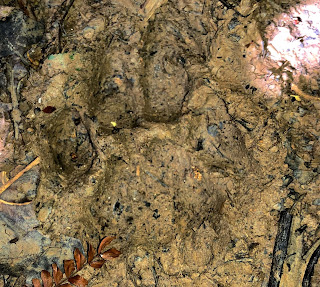 |
| A Jaguar Footprint. |
The largest wild carnivore I have ever seen is a coyote. To be in the realm of a jaguar (the indigenous word means “one who kills with a single pounce”) was breathtaking. I looked at the surrounding jungle with new eyes. Moments ago, the world’s third largest big cat had stood in the exact spot I was standing in now. It could be watching us from only feet away and its camouflaged pelt would make us none the wiser. I held my breath as we continued down the trail. The salt pool itself held little of interest, but that single paw print made it all worth while. Just to share the landscape with such a mysterious and impressive carnivore was one of the highlights of the entire trip.
That night, an even larger species of rain forest mammal would pay us an unexpected visit.
More soon.
Keep living the field life.
RBW






























